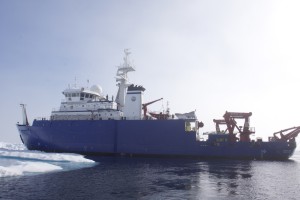by Mary Dzaugis, University of Rhode Island
We are starting our trip across the Pacific from Hawaii to San Diego aboard the R/V Sikuliaq [see-KOO-lee-auk]. Sikuliaq is an Inupiaq name meaning ‘young sea ice that is safe to walk on’. This is an appropriate name for this 261 foot, Polar Class 5 research vessel as it is built to break through about a meter of first year sea ice. The new research vessel is owned by the National Science Foundation and operated by the University of Alaska Fairbanks College of Fisheries and Ocean Sciences. It was launched in 2012 and began science operations in 2014. The ship has travelled around the world and conducts scientific surveys in the open seas, near shore and in single-year sea ice regions. The ship berths up to 26 scientists along with 20 crew and 2 marine technicians.
A number of features on the Sikuliaq were designed to work at high latitudes where ice may be present. The ship has an ice knife in the front to help break through ice cover. The propulsion on this ship is specially designed for handling ice. The thrusters pull the ship through the water chewing and chipping the ice, like a margarita maker, before the ice can hit the more sensitive pod. This means the propellers are facing to the direction the vessel is moving. In addition, the Sikuliaq has broad shoulders and narrow waist to reduce ice resistance.
For our travels we won’t be utilizing the ice-cutting capabilities of this ship, but we will be using many of the pieces of equipment the Sikuliaq offers. The main tools we will use are an echosounding instrument to map the bottom of the ocean floor, seismic reflection to view the sediment and rock layers beneath the seafloor, and a gravity corer to collect seafloor sediments.
We will post more details about our specific projects when we reach our stations of interest. For now, we are enjoying getting to know the capabilities of the ship, and learning how to use the monitoring systems onboard.

